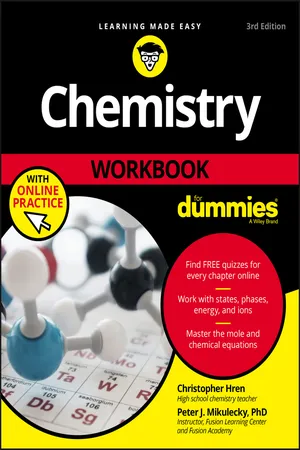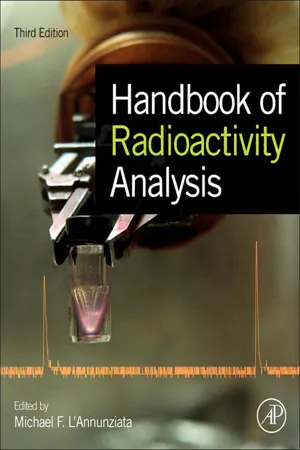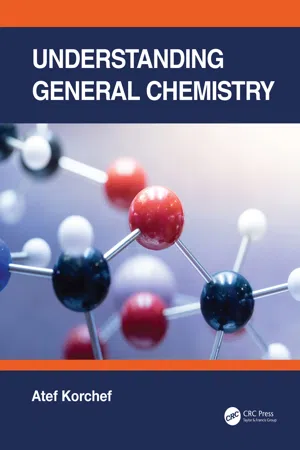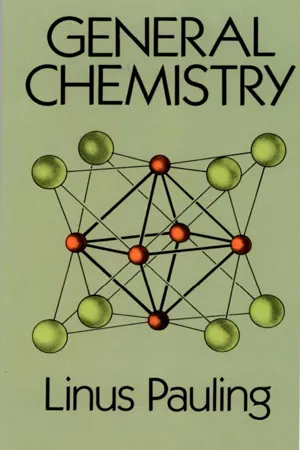Chemistry
Relative Atomic Mass
Relative atomic mass is the average mass of an element's atoms compared to the mass of a carbon-12 atom. It is expressed in atomic mass units (u) and is calculated by taking into account the abundance of each isotope of the element. This value is used to compare the masses of different atoms in the periodic table.
Written by Perlego with AI-assistance
Related key terms
Related key terms
1 of 4
Related key terms
1 of 3
10 Key excerpts on "Relative Atomic Mass"
- eBook - ePub
- Nigel P. Freestone(Author)
- 2016(Publication Date)
- Bentham Science Publishers(Publisher)
Relative Atomic & Formula Mass, Percentage Composition, Empirical & Molecular Formulae Nigel P. FreestoneKeywords: Atoms, Average Relative Atomic Mass, Calculations, Empirical and molecular formula, Isotopes, Percentage composition, Relative Atomic Mass (Ar ), Relative formula mass (Mr ).1.1. Relative Atomic Mass (AR )Chemical elements are the building blocks from which everything is constructed, from specks of dust to mobile phones and from flora and fauna to the clothes we wear. There are over a 100 known elements. An element is a pure substance that cannot be chemically broken down. The smallest unit of an element is the atom. Different atoms have different masses. The mass of an atom is so small that it is more convenient to compare atom masses, rather than refer to their actual mass. The standard for this relative scale is an atom of carbon-12, which has a Relative Atomic Mass (Ar ) of 12.The Table below lists the Relative Atomic Mass (Ar ) values of some common elements.Selected Relative Atomic Mass Values
Element Approximate Relative Atomic Mass (Ar ) Hydrogen 1 Carbon 12 Nitrogen 14 Oxygen 16 Sodium 23 Magnesium 24 Silicon 28 Calcium 40 Bromine 80 These Relative Atomic Mass values tell us for example that sodium atoms (Ar = 23) are 23 times heavier than hydrogen atoms (Ar = 1), two atoms of neon (Ar = 20) have the same mass as one atom of calcium (Ar = 40) and that three oxygen atoms (Ar = 16 ) weigh the same as two magnesium atoms (Ar = 24).Relative Atomic Masses are listed in the periodic table.Isotopes
Elements are defined by their proton (atomic) number. An atom with 7 protons is always nitrogen (N), an atom with 20 protons is always calcium and an atom with 70 protons must therefore always be gold (Au). Isotopes are atoms that have the same number of protons, but have different numbers of neutrons. For example, carbon has three naturally occurring isotopes, often referred to as simply carbon-12, carbon-13 and carbon-14, with Relative Atomic Masses of 12, 13 and 14, respectively. Since carbon has a proton number of 6, the isotopes contain 6, 7 and 8 neutrons, respectively. - Josef Kunes(Author)
- 2012(Publication Date)
- Elsevier(Publisher)
T ) of gases from critical values. Thermodynamics.Info: [C110] .2.1.55 Reduced Volume v red
v (m3 kg−1 ) – gas or vapour specific volume; v crit (m3 kg−1 ) – gas or vapour specific volume at critical state.It serves to compare and predict the properties (p , v , T ) of gases from critical values. Thermodynamics.2.1.56 Relative Atomic (Molecular) Mass A r , M r
m A (kg) – atomic mass; m M (kg) – molecular mass; u (kg) – atomic mass unit (1.66057×10−27 kg); m M (kg mol−1 ) – molar mass.The Relative Atomic Mass of an atom is a dimensionless number indicating how many times the atomic mass is greater than the atomic mass unit. Similarly, the relative molecular mass of a molecule is a dimensionless number indicating how many times the molecular mass is greater than the atomic mass unit. The relative molecular mass can be calculated as a sum of all Relative Atomic Masses of all atoms of a molecule. The atomic mass unit is defined as 1/ 12 of the mass of the carbon isotope nuclideThe molar mass gives the 1-mole quantity substance mass. The pure substance molar mass can be calculated as a quotient of its mass and its mass quantity or as a product of the atom (molecular) mass and the number of atoms (molecules) in one mole of the substance,which is valid for the molar mass in the kg mol−1 . For the molar mass in g mol−1 units, the relation M m =M r is valid. Therefore, the relative molecular (atomic) mass corresponds numerically to the molar mass expressed in the g mol−1 units. For example, for the relative molecular mass of carbon dioxide CO2 , one obtains (12+2×15. 9994)=43. 9988. Hence, the CO2 molecule has the molecular mass of 43.9988u and the molar mass of 43.9988 g mol−1- Chris Hren, Peter J. Mikulecky(Authors)
- 2017(Publication Date)
- For Dummies(Publisher)
However, even this minor change has some useful consequences. Scientists compare the ratio of carbon-12 to carbon-13 within meteorites to help determine their origins.- Carbon-14 ( , or carbon with six protons and eight neutrons) shows its interesting little face in only one out of every trillion or so carbon atoms. So if you’re thinking you won’t be working with large samples of carbon-14 in your chemistry lab, you’re right!
These three isotopes are why you see carbon’s atomic mass on the periodic table written as 12.01. If you do a quick bit of deductive reasoning, you can probably determine that carbon-12 is far and away the most common of the three isotopes due to the average atomic mass being closest to 12.Precise measurements of the amounts of different isotopes can be important. You need to know the exact measurements if you’re asked to figure out an element’s atomic mass. To calculate an atomic mass, you need to know the masses of the isotopes and the percentage of the element that occurs as each isotope (this is called the relative abundance ). To calculate an average atomic mass, make a list of each isotope along with its mass and its percent relative abundance. Multiply the mass of each isotope by its relative abundance. Add the products. The resulting sum is the atomic mass.Certain elements, such as chlorine, occur in several very common isotopes, so their average atomic mass isn’t close to a whole number. Other elements, such as carbon, occur in one very common isotope and several very rare ones, resulting in an average atomic mass that’s very close to the whole-number mass of the most common isotope.Q. Chlorine occurs in two common isotopes. It appears as 75.8% of the time and as 24.2% of the time. What is its average atomic mass?A. 35.5 amu. First, multiply each atomic mass by its relative abundance, using the decimal form of your percentage ( ):Then add the two results together to get the average atomic mass:Compare your answer to the value on your periodic table. If you’ve done the calculation correctly, the two values should match or at least be very, very similar.- eBook - ePub
- Jeffrey Gaffney, Nancy Marley(Authors)
- 2017(Publication Date)
- Elsevier(Publisher)
1 H.The atomic mass of an element, also called atomic weight, is different from the mass number and represents an average of all the naturally occurring isotopes. The atomic mass is determined as the sum of the masses of each isotope of the element multiplied by the fraction of its natural abundances. Since naturally occurring carbon consists of about 99% 12 C (six neutrons, six protons, and six electrons) and about 1% 13 C (seven neutrons, six protons, and six electrons), the atomic mass of carbon is determined from the following;Atomic mass C =mass0.99 +C 12mass0.01C 13(1)Even though we know the exact masses in grams of the three fundamental subatomic particles (Table 2.1 ), it is more convenient to use the atomic mass unit (amu), also called a Dalton, to define an element's mass. The atomic mass unit is defined as one twelfth of the mass of a single carbon atom containing six neutrons, six protons, and six electrons (12 C). Carbon-12 is assigned a mass of 12.000 amu and 1 amu = 1.66054 × 10− 24 g. The atomic mass of the element carbon calculated from the average of its two isotopes is slightly higher than 12. The average of 12 C with a natural abundance of 0.99 and 13 C with a natural abundance of 0.01 gives the element carbon an atomic mass of 12.0107 amu.•The important fact to remember in chemistry is that atoms with the same number of protons will have the same chemistry because the number of protons determines the number of electrons and the electrons control the chemistry. Added neutrons only add mass, but do not change the chemical behavior of an element. - eBook - ePub
- Michael F. L'Annunziata(Author)
- 2012(Publication Date)
- Academic Press(Publisher)
i ) with i = 1−n of a selected chemical element, the average atomic weight (A.W.) of this element can be calculated.(13.3)Because the sum of the relative abundances of all isotopes of an element is 100%, it can be written as(13.4)The age and origin of radioactive material including (hot) particles can be determined by their isotope signature. For example, the 240 Pu/239 Pu ratio observed might be used as a “fingerprint” in identifying the distribution of Chernobyl-derived Pu in the environment and in distinguishing it from other sources, e.g., global fallout (Muramatsu et al., 2000 ).Variations of isotope abundances are usually presented as δ values of an isotope expressed as per mil [‰]:(13.5)One problem is the availability of reliable reference materials for isotope ratio measurements. Certified isotope standard reference materials are available from NIST (National Institute of Standard Reference Materials, http://www.nist.gov/srd/ , formerly NBS – National Bureau of Standards) and IRMM (Institute for Reference Materials and Measurements, http://www.irmm.jrc.de ). For example, for uranium, a series of uranium oxide NIST isotope standard materials U005, U020, U350, U500 or U930, and others are available.Reliable standard materials for the precise and accurate measurements of n (238 U)/n (235 U) isotope ratios in natural sample materials have taken on an increasingly important role in modern geochemistry (Richter et al., 2010 ). Recent findings by Richter and co-workers do not only show variability for the n (238 U)/n (235 U) isotope ratios in nature of up to 0.13% but also emphasize that accurate n (238 U)/n (235 U) isotope ratios are needed for reliable and consistent Pb–Pb dating of geological samples. The commonly used ‘consensus value’ of 137.88 for the n (238 U)/n (235 U) isotope ratio of the NBS SRM 960 (NBL CRM 112a) standard has been re-measured in a collaborative effort by several geochemistry laboratories and the Institute for Reference Materials and Measurements (IRMM), who produced the isotopic reference materials used for these measurements. The new data have been acquired using a variety of new isotopic reference materials, for example, the new gravimetrically calibrated n (233 U)/n (236 U)-double spike IRMM-3636, combined with new measurement methods, resulting in a new average value of 137.837(15) for the n (238 U)/n (235 - eBook - ePub
Chemistry
With Inorganic Qualitative Analysis
- Therald Moeller(Author)
- 2012(Publication Date)
- Academic Press(Publisher)
In chemistry it is frequently of vital importance to know the number of atoms or molecules in a weighable amount of a substance or, conversely, to know the weight of a specific number of atoms or molecules. The conversion factor between these two levels of information is provided by the mole. The mole is a unit that represents the exact number of particles in a specific weight of a substance in grams. The following sections explain how we express the weights of atoms and molecules and how we relate them to larger amounts of substances via the mole concept.2.6 Atomic weight
For the early chemists using a relative scale of atomic weights was a necessity—they had no method for weighing an atom. Today we have sophisticated techniques for determining the masses of atoms with great accuracy. We know that one atom of uranium, one of the heaviest naturally occurring elements, has a mass of 3.9527 × 10−22 g, and that one atom of hydrogen, the lightest element, has a mass of 1.67380 × 10−24 g. The true mass of an atom is the value of its mass in mass units, such as grams. But we still use a relative atomic weight scale because it is more convenient. It is much easier to think of a uranium atom as about 238 times heavier than a hydrogen atom than to deal with numbers with more than 20 zeros after the decimal point.Relative atomic weights are proportional to the true masses of the atoms. One element is chosen as a standard, it is assigned an atomic weight, and all other atomic weights are expressed relative to that standard. Hydrogen, which was assigned an atomic weight of 1, and oxygen, which was assigned an atomic weight of 16, have both been used as standards. Hydrogen was chosen because it is the lightest element. Oxygen was chosen because it forms compounds with nearly all of the elements and leads to atomic weights for many elements that are close to whole numbers. - eBook - ePub
- Max Planck, James Murphy(Authors)
- 2017(Publication Date)
- Muriwai Books(Publisher)
According to the Avogadrian Law the molecules of chemical elements often enter into the molecules of the combination not with their whole weight but only with a fraction of it. For instance, the molecule of steam is made up of one whole molecule of hydrogen and half a molecule of oxygen, whereas the molecule of hydrochloric acid is made up of half a molecule of chlorine and half a molecule of hydrogen. Therefore from the molecular weight we come to the atomic weight of an element as the smallest fraction which is found in a combination of elements. This atomic weight expresses the relative weights of each species of matter.Although in Avogadro’s Law the concept of atomic weight has a certain absolute significance, at the same time it has quite a relative connotation. The Avogadrian atomic weight is only a relative number. Therefore it cannot be determined except by an arbitrary reference to the atomic weight of some special element or other, such as Hydrogen=1 or Oxygen=16. Without reference to some such given term, the number describing the atomic weight would have no meaning. Therefore it has for a long time been the aim of chemical researchers to free the concept of atomic weight from this restriction and try to give it a wider and more absolute meaning. This problem, however, is not very important for the practical chemist; because in the chemical analysis of substances there is always the question of relative proportions among the combining elements.In every science it occasionally happens that there arises a conflict between two classes of people whom I may designate respectively as purists and pragmatists. The former strive always after a perfect coordination of the accepted axioms of their science, submitting them to an ever more and more rigid analysis, for the purpose of eliminating every contingent and foreign element. On the other hand, the pragmatists try to amplify the accepted first principles by the introduction of new ideas and thus send out feelers in all directions for the purpose of making progress. They do not mind if the mongrel be mated with the pure-bred, provided something can be achieved through the combination, which otherwise could not be achieved. In the science of chemistry also there are purists who set themselves against any attempt to make the concept of atomic weight something more than that of a merely relative number. But there are also leading chemists who find it at least practical to treat the atomic idea as it is treated in mechanical physics, that is to say, to consider the atoms as minute and independent particles occupying definite and measurable dimensions in the molecule, and being either divided or regrouped according as the molecule undergoes chemical changes. During my time in Munich, in the beginning of the eighties, I remember being very much impressed by the polemic that then raged in the university laboratory. Among the puritan chemists the leader was then Hermann Kolbe of Leipzig, who hurled his sacred anathema against the mechanical-atomic interpretation which was involved in the building up of chemical formulas for the constitution of various substances. When results were somewhat slow in being obtained by that process he generally grew all the more violent against the principle adopted. In the circumstances von Baeyer did the wisest thing that could be done. He kept silent and awaited results, until finally success crowned his efforts. - eBook - ePub
Pharmacology, Doping and Sports
A Scientific Guide for Athletes, Coaches, Physicians, Scientists and Administrators
- Jean L. Fourcroy(Author)
- 2008(Publication Date)
- Routledge(Publisher)
The aim of this chapter is to explain the basic concepts of the isotope ratio mass spectrometry technique such as the fundamental notion of isotopes, and the instrumentation, applications and methodology used to differentiate endogenous from exogenous steroids. In order to make clear the principles of this technique, a basic and simple definition will be given for each part of the isotope/ratio/mass/spectrometry/carbon/analysis.3 Definition of “atom”
In chemistry and physics, an atom (from the Greek átomos, meaning “the smallest indivisible particle of matter, i.e. something that cannot be divided”) is the smallest particle that still characterizes a chemical element.1 An atom consists of a dense nucleus of positively charged particles named protons and electrically neutral particles named neutrons, surrounded by a much larger electron cloud consisting of negatively charged electrons. Therefore, an atom is electrically neutral because it has the same number of protons as electrons. The number of protons in an atom defines the chemical element to which it belongs, whereas the number of neutrons determines the isotope of the element, as will become clear.Figure 6.1 Schematic of a static design (A) and dynamic beam of protons and electrons of the atom (B).4 Definition of “isotope”
In order to define the concept of an isotope, it is important to know that the atomic mass (A) of an atom is defined by the weight of the number of protons and neutrons in its nucleus. The electrons are not taken into account, as we know that their mass is 2,000 times less than that of protons.2 Atoms are very light in weight; one oxygen atom weighs only 0.000000000000000000000027 g. Because such a number is impractical to use, chemists instead use a unit based on an atomic standard of reference, carbon of mass 12, which is written 12 C. Another concept about an atom is the atomic number, which corresponds to the number of protons (which is equal to the number of electrons), namely Z.3Because the atomic mass is determined by the sum of the number of protons and neutrons contained in the nucleus, two atoms of, say, carbon that have a different number of neutrons, hence a different mass, are referred to as different isotopes of carbon. For example, carbon-12 and carbon-13 are referred to as different isotopes because 13 - eBook - ePub
- Atef Korchef(Author)
- 2022(Publication Date)
- CRC Press(Publisher)
One mole (1 mol) contains 6.022 × 1023 entities (atoms, molecules, ions).The atomic mass (the mass of one atom) is the average mass of all the isotopes of an atom with respect to their abundances. The atomic masses of all elements are given in the periodic table of elements. The atomic mass is commonly expressed in atomic mass units (amu).1 a m u =g = 1.660 ×1 /N Ag10− 24- Example: A calcium (Ca) atom has a mass of 40 amu. The mass of calcium atom in g is (40/NA ) g = 6.642 × 10−23 g
The molecular mass is the sum ofthe atomic masses of all the atoms in the molecule. It is commonly expressed in atomic mass units (amu).- Example: One molecule of sulfuric acid (H2 SO4 ) contains two atoms of H, one atom of S and four atoms of O. The molecular mass M of sulfuric acid is
M = 2 ×+ 1 ×atomic mass of H+ 4 ×atomic mass of Satomic mass of O=+2 × 1+1 × 32= 98 amu4 × 16The mass of one sulfuric acid molecule in g is (98/NA )g = 1.627 × 10−22 gFor monatomic elements, the molar mass (mass of one mole, abbreviated as M or Mwt ) is the numerical value on the periodic table expressed in g mol−1 .- Example: The atomic mass of O is equal to 16 amu and the molar mass of O is equal to 16 gmol−1 .
For molecules, the molar mass is the sum of the molar masses of each of the atoms in the molecular formula.- Example: A molecule of H2 O contains two H atoms and one O atom. The atomic mass of O is 16 amu and the atomic mass of H is 1 amu. The molecular mass of H2 O is equal to 16 + 2 × 1 = 18 amu and the molar mass of H2 O is equal to 18 gmol−1
- eBook - ePub
- Linus Pauling(Author)
- 2014(Publication Date)
- Dover Publications(Publisher)
34 S the lines for the doubly ionized atoms would lie near the line for singly ionized oxygen. Accurate relative measurements of these lines can then be made.Examples of the Determination of Atomic Weights with the Mass Spectograph
For a simple element, with only one isotope, the value of the atomic mass of that isotope is the atomic weight of the element. Thus for gold, which consists entirely of one stable isotope,197 Au, the mass-spectrographic mass is reported to be 196.967. This value has been accepted by the International Committee on Atomic Weights.For elements with two or more stable isotopes the atomic weight can be calculated from the masses of the isotopes and values of their relative amounts, as shown in the following example.Example 4-7 . Silver has two stable isotopes. Their masses as determined by use of the mass spectrograph were found to be 106.902 and 108.900, with relative amounts (numbers of nuclei) 51.35% and 48.65%, respectively. What is the atomic weight of silver, from this investigation?Solution . The average atomic weight is 0.5135 × 106.902 + 0.4865 × 108.900. We see that this can be rewritten as 106.902 + 0.4865(108.900 −106.902) = 106.902 + 0.4865 × 1.998 = 106.902 + 0.972 = 107.874. The value of the atomic weight of silver is accordingly calculated to be 107.874.4-9. Determination of Nuclidic Masses by Nuclear Reactions
A tremendous amount of information about nuclidic masses has been obtained by studying the energy released in nuclear reactions. A discussion of nuclear reactions is given in Chapter 26 . The following example illustrates the general method.Example 4-8 . The fraction 0.0118% of the element potassium in its natural occurrence is the radioactive isotope . It undergoes beta decay:The kinetic energy of the emitted electron (the beta ray) has been measured by use of a magnetic beta-ray spectrometer (measurement of the curvature of the path of the beta ray in a magnetic field) and found to be 1.32 MeV. The mass of 40 Ca, which is stable and constitutes 97% of natural calcium, is 39.96259 d, as determined with the mass spectrograph. What is the mass of 40
Index pages curate the most relevant extracts from our library of academic textbooks. They’ve been created using an in-house natural language model (NLM), each adding context and meaning to key research topics.
Explore more topic indexes
Explore more topic indexes
1 of 6
Explore more topic indexes
1 of 4









